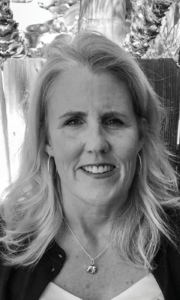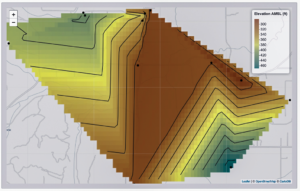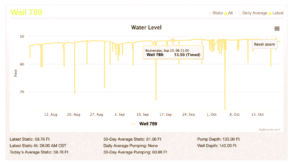Farmers can observe the weather, they can measure rainfall, and they can monitor how much water they pump out of their wells, but until now, it has been nearly impossible to measure their groundwater supply in real time. Groundwater is a dynamic resource that recovers from pumping at different speeds, depending on geology, precipitation, and the number and density of the wells that draw from it.
Wellntel, a technology company founded in 2012, has created a cloud-based platform that provides real-time groundwater supply information from a network of simple sensors installed on private wells. In this interview, Marian Singer, the cofounder and chief executive officer of Wellntel, talks with Municipal Water Leader Managing Editor Joshua Dill about her company’s innovative products and how they stand to benefit groundwater users.
 Joshua Dill: Please tell us about your background and how it led you to your current position.
Joshua Dill: Please tell us about your background and how it led you to your current position.
Marian Singer: Prior to founding Wellntel, my cofounder Nick Hayes and I were strategy consultants for large industrial companies, specifically in the water and energy space. Our job was to bring the voice of the customer and the market into clients’ new product- and service-development processes to better meet customers’ needs. In 2011, we got to take a team of engineers around the world to visit groundwater stress hotspots and talk to the folks buying, specifying, and using their products. While in Amsterdam, we learned about the Netherlands’ rich national groundwater monitoring dataset and map. We were inspired. We wondered whether we could take advantage of the 15 million existing private wells in the United States and local Internet connections and turn them into monitoring points using a simple, non invasive sensor. If we could do that, we could build maps of groundwater supply that would track changes in real time. That would give farmers and local communities the insight they need to sustainably manage their critical groundwater resources. We got enough nods of support from engineers, investors, and potential customers that we started Wellntel at the end of 2012. After 3 years of technology development, we launched commercially in 2015.
Joshua Dill: Please tell us about your company, Wellntel.
Marian Singer: Wellntel is an information platform for groundwater supply. We gather data from our sensors, which are deployed in a network on private wells across an area. Data from our sensors is transmitted to the cloud via local Internet connections, and our cloud engine prepares it for analysis and sharing. An online dashboard allows customers to see, for the first time, the water level in their well or wells and how it changes, the real-time effects of pumping and precipitation, seasonal drawdown and recovery, and long-term historical trends.
Groundwater-level monitoring has traditionally been expensive and cumbersome. Most of the time, it was done by a groundwater professional who would visit a well and use a tape to measure the water level as it was at that particular time, on that particular date. The well might not be visited again for months or years. That method doesn’t give groundwater managers, including communities and farmers, the rich, dynamic information that they need to make decisions.
We decided to do something different. Our sensor is designed to be simple and inexpensive. Because it’s noninvasive—it uses a digital form of sound to track the water level and is installed at the top of a well—it does not touch the water, thus eliminating the risk of contamination. We install the sensors on private wells whose owners voluntarily allow us to do so. It only takes about 30 minutes to install and register the device and get data flowing into the cloud. Measurements are transferred in real time to the cloud via a local Internet connection or, if the well is remote, via a cell modem. Our customers access their wells’ information via a secure, private, online dashboard that’s a living document of what is happening to their wells and the groundwater in their area. They can see the current water level and pumping activity, set alerts, and track changes.
Our customers are groundwater management agencies and farmers. For farmers, Wellntel provides the real-time information necessary to take action on operational alerts, as well as the longer-term, seasonal information necessary to make decisions on water storage and transfer and to resolve any disputes that arise. For community agencies, Wellntel provides a cost-effective platform to enhance and expand their groundwater-level monitoring, which is used to inform their growth decisions. Since Wellntel’s networks are built using the facilities of local private-well-owning volunteers, the data in the cloud are also securely shared with the volunteers, thus increasing local stakeholders’ understanding of their critical groundwater resources.
 Joshua Dill: Does your company make both software and hardware?
Joshua Dill: Does your company make both software and hardware?
Marian Singer: Yes. We had hoped that we could create a system using off-the-shelf sensors and firmware, but suitable products weren’t available. We developed the firmware and cloud engine needed to make our systems accurate and secure and designed a purpose-built sensor and telemetry system to deploy in the field. We assemble and ship the systems out of our Milwaukee headquarters.
Joshua Dill: What is new about the services that Wellntel provides?Marian Singer: Wellntel is the first company to provide real-time groundwater supply information on a network-scale basis and make it available to groundwater managers as well as private well owners. We can also bring third-party data into our platform. Early in 2019, we will be announcing the addition of a new capability that provides estimates of gallons pumped for wells without a meter. With this information, our customers will have both supply and demand on a single dashboard, providing new insight into pumping-volume effects and aquifer health.
Joshua Dill: Who are your customers?
Marian Singer: Our customers are groundwater management agencies and groundwater-dependent businesses, including farmers, food processors, and mining operations. Wellntel has a presence in 35 states. A majority of our customers are in the West, with California, New Mexico, and Texas leading the way.
Joshua Dill: What makes your product appropriate for irrigators?
Marian Singer: Farmers want to stay on their land and keep their business profitable and growing. To do that, particularly in groundwater-stressed areas, they need to understand the state of their groundwater resources, the effects of their irrigation, and the dynamics of annual recovery so that they can sustainably manage their land and their farms. Wellntel helps them do that. It also helps them create a database so that, in the case of a legal dispute, they can demonstrate that they have been good caretakers of their water.
Joshua Dill: Has your service led to any unexpected results or discoveries about water supplies?
Marian Singer: Observing groundwater supplies in real time for the first time can lead to surprising discoveries, particularly about the health of the groundwater supply. We’ve had farmers in the West who were happy to discover that they have robust, quick-recovering groundwater supplies. Others saw that it took 2–4 months in the offseason for their wells to recover. This information helps them start to understand the effects of their own pumping and to differentiate it from the effects of outside factors.

Joshua Dill: Would you tell us about your sales strategy?
Marian Singer: Right now, we are selling directly to both agencies and farmers. Because we are doing something brand new, we can’t send an email and have customers intuitively understand the value of our service. We need to have conversations to identify and address our customers’ challenges. We find customers by attending local meetings, association meetings, and trade shows. Customer referrals are our most powerful marketing tool. One of our goals in 2019 is to find the right channel partner to help us to deploy our system on a broader scale.
Joshua Dill: Would you speak about your experience as a female chief executive officer in the water industry?
Marian Singer: I think my experience in the water industry is similar to my experience in industrial markets. Many of our customers are men, although the percentage of women in the water industry, in water science, and in farming is growing. As a woman in the water industry, with the people and customers I get to work with, it’s a really fun experience all the way around. I think that it’s really cool to see more women taking an active role, particularly in family farming businesses.
Joshua Dill: Would you tell us about your vision for the future of your company?
Marian Singer: Our vision for Wellntel is to make groundwater visible and to inform sustainable management. We believe that farmers, homeowners, and communities that depend on groundwater should have the information that allows them to make the decisions that enable them to stay in the places they love. Knowing about and understanding their groundwater resources is the key to doing that. We want farmers to not only be able to check their weather forecast each morning, but also to be able to check their groundwater forecast and to make groundwater monitoring an integral part of their planning and operations.
Marian Singer is cofounder and chief executive officer of Wellntel. She can be contacted at mjsinger@wellntel.com.
